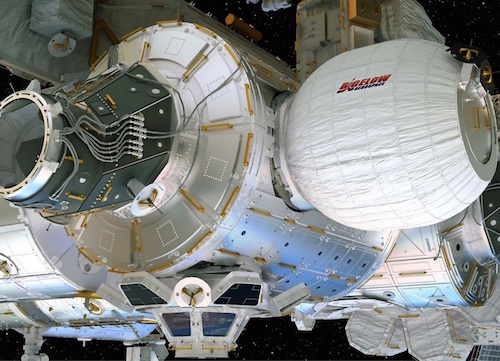‘BEAM’ – The Inflatable Space Room Attached To International Space Station (ISS)
The International Space Station (ISS) has received an updated from Bigelow Aerospace – an experimental plug-in model of an inflatable room to grow the living space on the space station. The new ‘room’ was added on Saturday, but it will be close to a month when it becomes livable for the astronauts. It is believed that larger expandable modules might some day become independent free-flying space stations themselves.
Called BEAM, or Bigelow Expandable Activity Module, was connected to the rear-facing port of the space station’s Tranquility node. This is the first update made to the ISS in the past five years. The 1,400kg (3,100 pound) weighing module was manufactured by Bigelow Aerospace, and was launched aboard an unpressurized SpaceX Dragon cargo capsule that reached the station on Sunday.
Flight controllers at NASA’s Mission Control in Houston began transmitting commands to the space station’s robotic arm Canadarm2 early Saturday, where they ordered the arm to extract the deflated, compressed BEAM from the Dragon and transfer it to position next to its connection point on the Tranquility module. Astronauts Tim Kopra and Jeff Williams then secured the BEAM from onboard ISS using common berthing mechanism controls. By 1012 GMT, the space station had its first privately built room.
Built from impact-resistant, Kevlar-like materials and other fabrics, launch costs of such lightweight habitats like BEAM could save money to the tunes of millions of dollars when compared with launch costs of metal modules. They may even provide better radiation protection for astronauts, claimed NASA and Bigelow Aerospace officials.
BEAM was compacted for its launch to 7 feet diameter and 8 feet length, and by the end of May the same shall be inflated to five times its size. The space station’s air supply will be used to inflate the module to its normal shape, and once the shape is achieved BEAM’s own air tanks will take over and pressurize the module around May 26. The station’s crew shall first enter the experimental room a week later, and during BEAM’s test mission through 2018, will keep frequenting the room for a few hours many times a year to retrieve sensor data and to study its conditions.
This is not all. Robert Bigelow mentioned that they’re already working on an operational module that are 20x the size of BEAM, almost like a small bedroom. Nicknamed B330, it’s designed to be a free-floating habitat with 12,000 cubic feet, that is 30 percent more space to the outpost and support NASA and many other commercial projects. The company is chalking out time-share agreements to lease space aboard the module to commercial organisations, research groups and even to space tourists.
Watch the video below-
You may also like...
1 Comment
Leave a Reply
Cancel reply
-
Advertisement
Copyright © 2020 Indian Nerve. All Rights Reserved.



Innovations
March 16, 2022 at 11:48 pm
Astronauts Tim Kopra and Jeff Williams then secured the BEAM from on board the station using the complex’s common berthing mechanism controls. By 6:12 a.m. EDT (1012 GMT), the space station had its first privately built room.